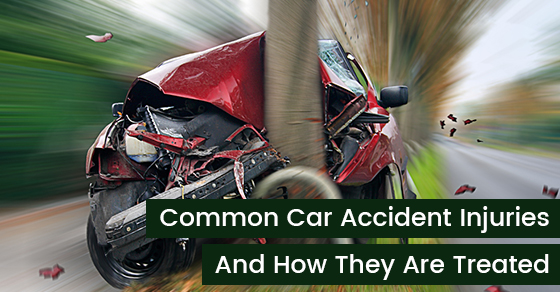There are many factors that can cause vehicle accidents, and the injuries sustained can range from severe to mild. No two car accidents are alike. However, the type of injuries sustained after a vehicle collision is generally similar because there’s only so much movement that the human body can do in a confined space at the moment of impact. Continue reading for the top 5 common car accident injuries:
-
- Whiplash:
When the head jerks violently, it creates stress on the neck and spine, causing whiplash. This type of injury more commonly occurs after a rear-end collision. If left untreated, the effects of whiplash can lead to long-lasting adverse health issues. The symptoms of whiplash can develop in as little as 24 hours after the accident and include blurred vision, dizziness, fatigue, neck stiffness and pain, headache, limited neck movement, numbness in the arms, and pain in the shoulders, arms or upper back area. In severe cases, whiplash can cause memory and concentration issues and depression. The treatment for whiplash can be quite intensive and take time to unfold because the injury itself requires ample healing time. Whiplash treatment usually involves the use of muscle relaxants and anti-inflammatory prescription medication to help with the pain and discomfort. Furthermore, your doctor will recommend a physiotherapist to help you with range of motion exercises, massage to promote tissue healing, and ultrasound therapy. You may also be asked to wear a neck brace to support the weight of your head as you heal.
- Whiplash:
-
- Concussion:
When we receive a severe blow to the head, our brain can actually move inside our skull, causing a traumatic injury. Concussions sometimes go undiagnosed after vehicle accidents because the symptoms can take time to appear. The symptoms include headache, double vision, nausea, sensitivity to loud noises and light, and even loss of consciousness. Concussion treatment involves rest followed by physical therapy to help you regain your balance and strength, massage, motion exercises and electrical stimulation. In severe cases, when a brain scan reveals internal bleeding or swelling, surgery is needed.
- Concussion:
-
- Herniated disc:
The impact of a car accident can cause one or more of the back’s small discs to shift out of alignment. Herniated discs can create ruptures to the area resulting in pain, nerve injuries that travel all the way down to the thighs, and severe weakness. To determine if you have a herniated disc (or discs), imaging tests, X-rays, CT scans and MRIs can all be used. Treatment for herniated disc(s) revolves around rest, applying ice and heat to the area, spinal decompression and adjustments, and visiting a physiotherapist for range of motion exercises and massage. If the injury is severe enough, surgery may be required. You will also need to work with a physical therapist after surgery to help you regain your strength.
- Herniated disc:
-
- Lower extremity injuries:
The impact of a car accident can cause knee, leg and foot injuries. These type of injuries usually occur when drivers are not wearing their seatbelt because the impact of the collision can push their knees into the steering column and dashboard. The symptoms of lower extremity injuries can include pain and broken bones. Treatment will involve pain medication, crutches to keep pressure on the area and physiotherapy. Surgery may be needed for severe cases of lower extremity injury.
- Lower extremity injuries:
- Chest injuries:
Cracked or broken ribs are common after vehicle accidents because the impact can send you forward into the dashboard and steering wheel. Moreover, the pressure of the seatbelt pushing into your lap and chest can also cause chest injuries. The symptoms range from pain to trouble breathing to nothing at all. In fact, organ bruising and other internal damage is not easily detectable, so you may need to undergo a full-body scan and X-ray to determine the extent of the damage. The treatment for chest injuries is rest and pain medication, followed by physiotherapy to strengthen the muscles again.
Why visiting a physiotherapist after a car accident is necessary
Following a car accident, your physician will send you for treatment at a physiotherapy clinic. Even if your doctor prescribes rest and pain medication, you will still need to work with a physiotherapist to help with the healing process. When we rest for long periods of time, our strength diminishes and we can re-injure ourselves easily. A physiotherapist is trained to help you get back on your feet without the chance of reinjury. Rehabilitation following a car accident can take months to get you back to your old self, and a physiotherapist will create a program that is specifically designed for your body and needs. In addition, physiotherapists will work in tandem with your physician to help with pain management.
If you’ve been injured in a car accident, please contact us. At Focus Physiotherapy we will do our part to ensure you get the treatment necessary to treat common car accident injuries to get you back on your feet.

